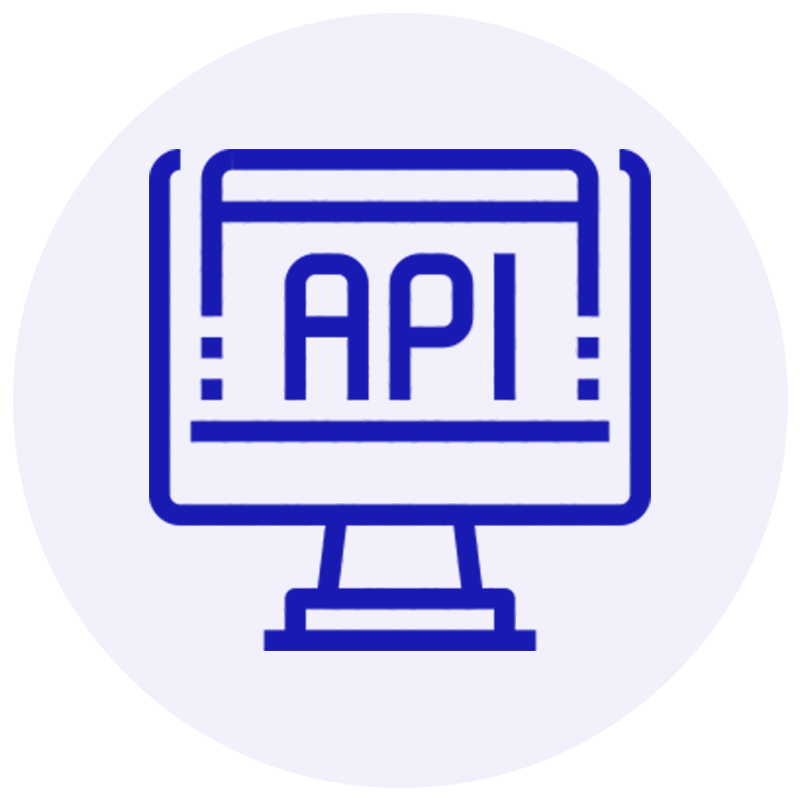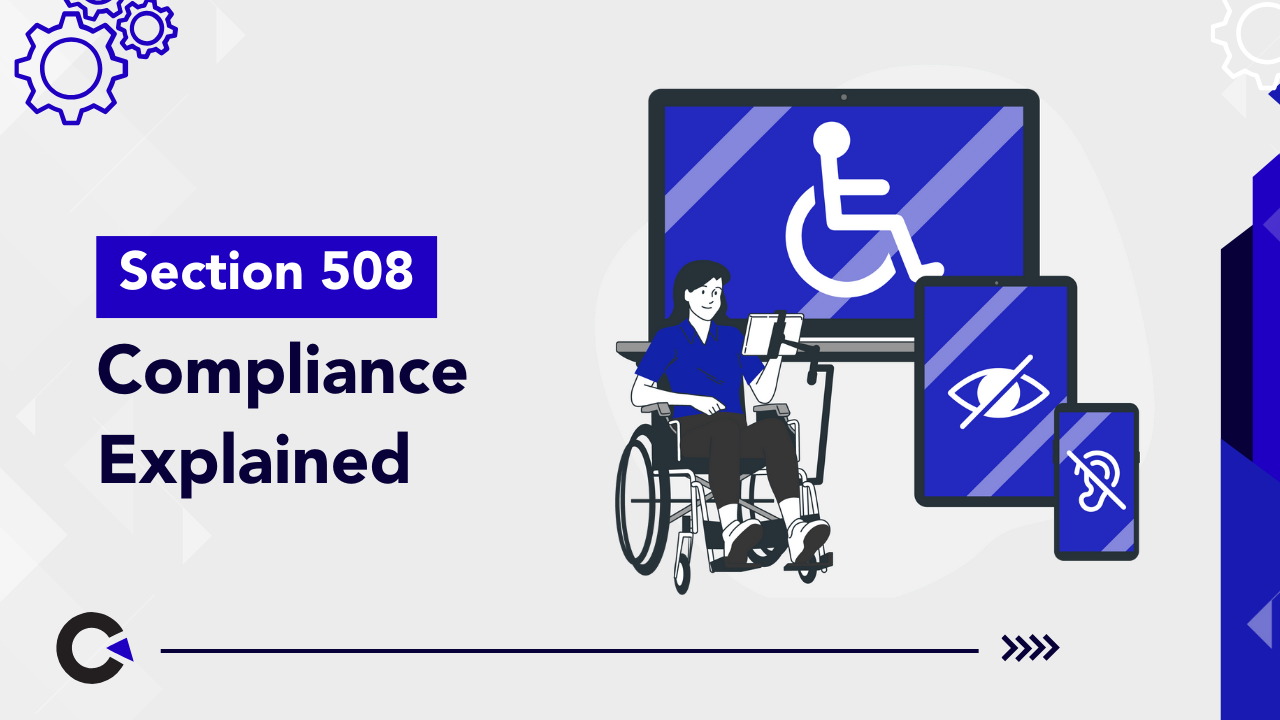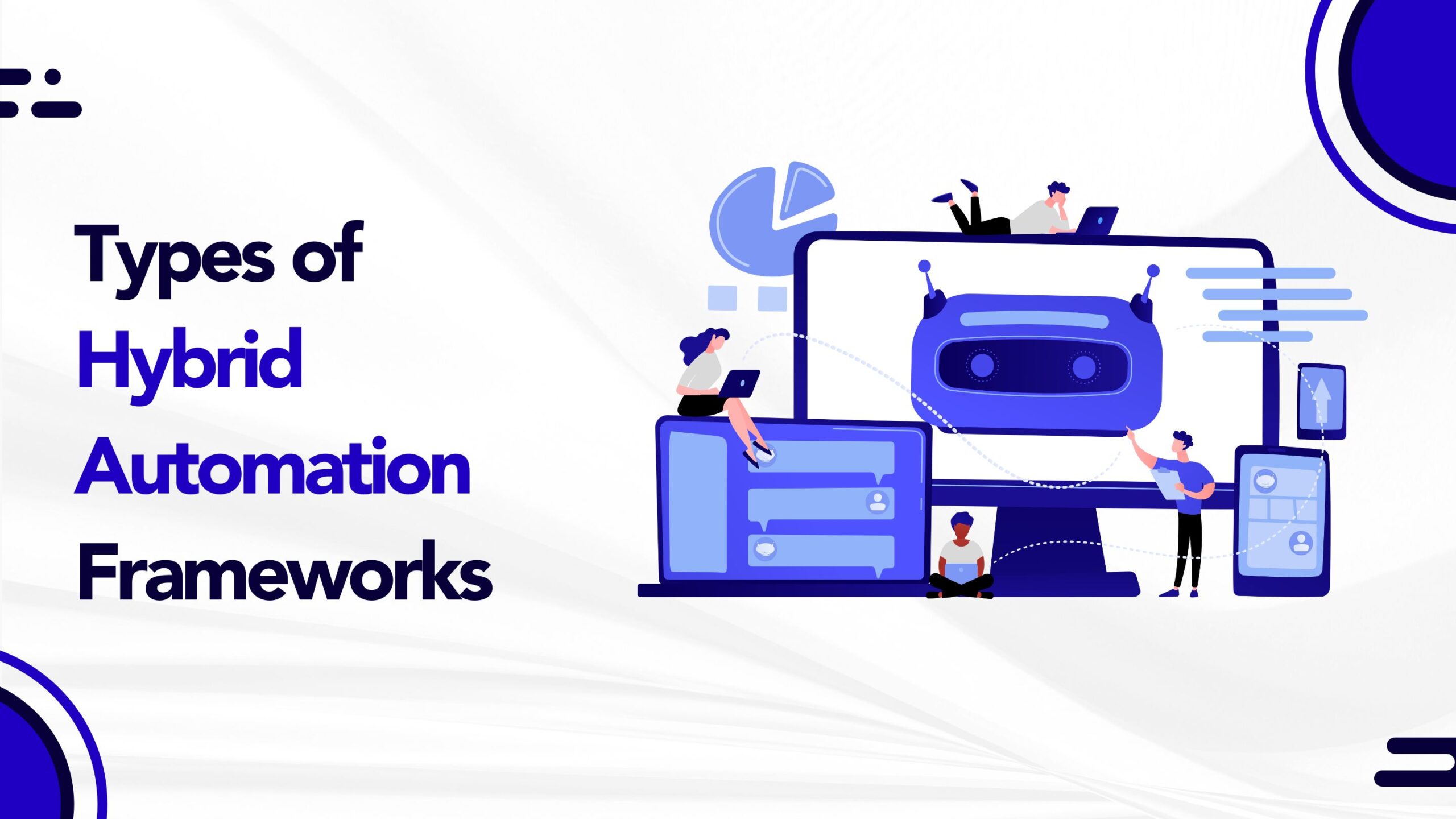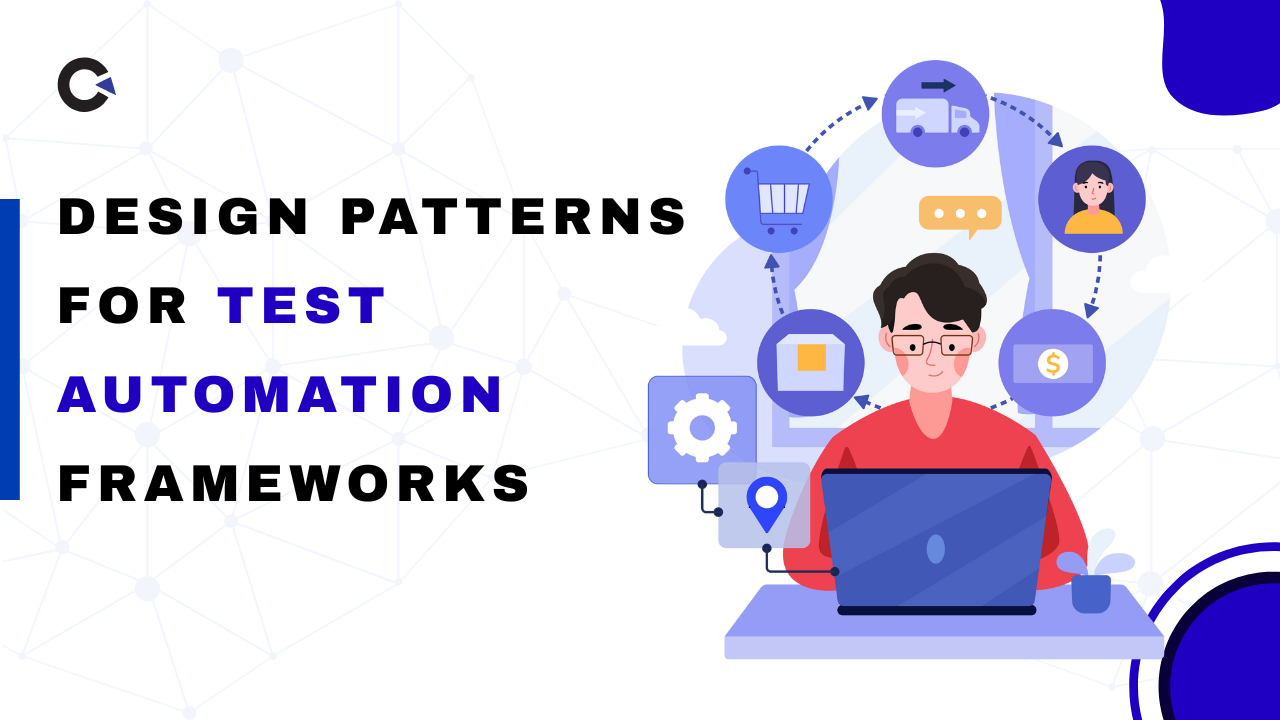
by admin | Sep 2, 2021 | Mobile App Testing, Blog, Latest Post |
The advent of technology has enabled many businesses to thrive through the power of the internet. There used to be a time when ventures had to rely on their physical shops and traditional means of advertising to establish presence and relevance in the market. Nowadays, it’s all about the eCommerce platform and its ability to showcase different products through an intuitive and user-friendly platform.
If you happen to run your online store, chances are you’re still trying to find ways to make it trend in your market. When promotional materials aren’t cutting it anymore, it may be time to invest in a mobile app to represent your online store.
It may seem trivial at first until you realize the different advantages that it may provide towards your venture:
1. A Wider Reach
Investing in the creation of a mobile application for your online store will attract more people to your products and lengthen your reach amongst the target market in general.
Most people now use their cellphones to accomplish various tasks and transactions, and investing in mobile apps means you wouldn’t be left behind, primarily if your competitors utilize them as well. Strike while the iron is hot and grab the opportunity to have your online store app now! Increase your sales by having more leads and customers upfront.
2. An Ever-Changing Trend in Sales
Mobile apps are customizable. Sure, you may retain its primary function as a storefront for all your products and branding. However, you may still change how they will be represented by utilizing different placements and designs, all of which can be accomplished with the help of your programmers and designers.
Remember that this may require you to look at the data from time to time to determine which designs are trending and how they may best acquire the appropriate reactions towards your brand. Just remember to be in sync with your data and creative team so that the core messaging of your brand will not come in conflict with the app.
3. A Whole List of Options and Preferences
Thanks to a mobile app, your target audience will never have to be limited by the options offered by your online app store. They will all have a specific rundown of products while hiding all the rest that they’re not interested in. For example, if you happen to be looking for a television, chances are you do not have any patience to go through a list of washing machines and vacuum cleaners just to find that 24-inch flatscreen.
If you want to attract more customers to your brand, implement this feature to add convenience to the interface. Just be sure to hire the help of mobile testing services so that this will be executed flawlessly.
Conclusion
There are various reasons an online store may need to invest in mobile application development. So as long as you know the different advantages that it may provide towards your brand, you may be able to make the most out of its functionalities and deliver an app that doesn’t alienate your intended market.
Focus on getting a wider reach, adjust according to ever-changing trends, and offer user-friendly navigation that your target audience will love in the long run. Do this all efficiently and watch your sales grow over time!
If you want to ensure the quality of your mobile app, you may need the help of mobile application testing services. In that case, we at Codoid will be more than happy to help you. We provide a wide range of QA services ranging from analytics and regression testing to mobile apps and game testing. Contact us today!

by admin | Aug 31, 2021 | Automation Testing, Blog, Latest Post |
We live in an era where instant gratification is wanted by each customer that buys a product or service. Knowing this, it is critical that businesses keep up with their customers’ expectations to prevent losing sales and customers to their business rivals. To do this, it is a must that companies administer continuous testing to their software to ensure that it will always be up to par with what customers expect.
However, getting started with continuous testing may not be something that comes naturally to everyone. Plus, even if you do get the ball rolling for your continuous testing for your software development processes, you may still face some significant roadblocks. This blog post will shed some light on what these possible challenges may be and how to deal with them.
Major Roadblocks of Continous Testing: What You Can Do
There are three major roadblocks that may hinder the development of the software that you offer. Overcoming these challenges is the key to ensuring that you keep your clients happy and satisfied in the long run.
1 – Bottlenecks Caused by Time and Resource Restrictions
Many times, the time and resources that are needed to complete sustainable development and test automation are underestimated. This being said, testing may come to a halt if these considerations are not thought of beforehand.
What You Can Do: Before getting started, it is vital to establish a testing agenda that supports reuse and data-driven testing. It is also critical that the testing team keeps individual test results up to date with the improvements being made to the software.
2 – Complexity
It can be extremely easy to get lost in the technical complexity of the test automation process. This task requires a vast amount of technical knowledge to be done correctly.
What You Can Do: To ensure that a team overcomes this roadblock, they need to understand how to automate the testing process and connect the data and results across different technologies. An in-depth understanding of these processes will help weed out critical defects and reduce complexities while undergoing continuous testing.
3 – Addressing the Results
As the continuous testing process goes on, there will come a time where there an immense amount of results will be produced. These results will render an extremely high amount of false positives. Looking into and analyzing these results may become tedious and highly time-consuming for the testing team.
What You Can Do: It may take time, but it pays to look into each result and take each one into consideration when making a release decision about your application or software products.
Conclusion
It is often said that we are now living in the Digital Age. It is getting more and more difficult to please clients. Producing state-of-the-art software that is cutting edge enough to satisfy your clients can only be done when you continually improve your products. Following the tips mentioned above and working with a reliable, tried-and-tested QA team will help you make sure that your software is always at the top of its game.
Should you need help in test automation services for your software, Codoid is an industry leader in QA. We don’t say this just to brag; we say this because it is our passion to help guide and lead the Quality Assurance community. Our brilliant team of engineers love to attend and speak at: software testing meetup groups, forums, Software Quality Assurance events, and Automation testing conferences. Contact us and let us help you test your applications today!

by admin | Aug 30, 2021 | Automation Testing, Blog, Latest Post |
Nowadays Appium is being prominently used for identifying Xpath or locators in both Android and iOS apps. But when it comes to iOS, we would have to spend a lot of time configuring the real device using Xcode for Building the WebDriverAgent. If in case we don’t have the latest iOS Version, iPhone Version, and Xcode version, then we will be facing configuration issues. This is where a cloud testing platform like BrowserStack comes into the picture as an easy solution and alternative to such problems. So if you were looking for the steps to use BrowserStack for inspecting a mobile app’s locators, then you’re in the right place. As a leading automation testing company, we have been using BrowserStack for a long time. So in this BrowserStack Tutorial, we will be showing you how to use BrowserStack as a UI inspector for both Android and iOS apps.
App Live
Make sure to install BrowserStack and keep it ready to do the following steps. If you are still on the fence about purchasing an account, you can still use their trial period to check out how well it fits your needs. So now let’s see how we can test our mobile apps and view the developer logs via DevTools and also identify the mobile elements using the ‘Inspect’ option in DevTools.
Navigate to App Live as shown in the image below,
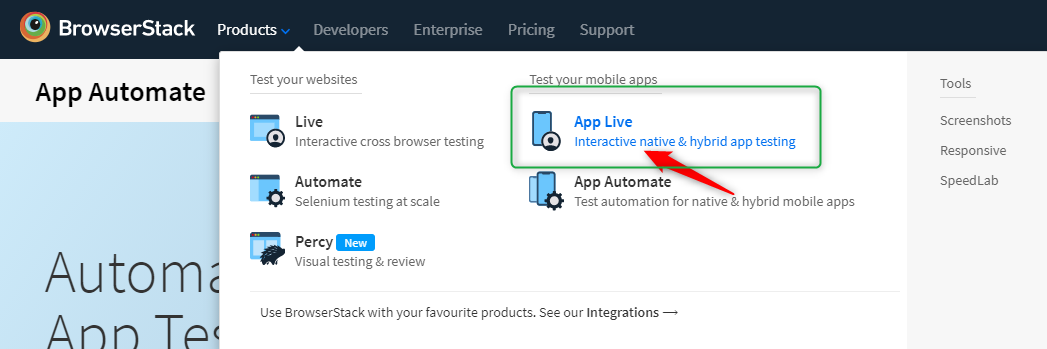
Let’s a look at the 7 easy steps that have to be followed in this BrowserStack Tutorial now,
i. Click on ‘Test with a Sample app’ as shown in the image.
ii. Upload your App using the given option. If it’s an Android app then upload your apk file here, if it’s iOS, upload your ipa file here.
iii. Select the device you want to test the app in.
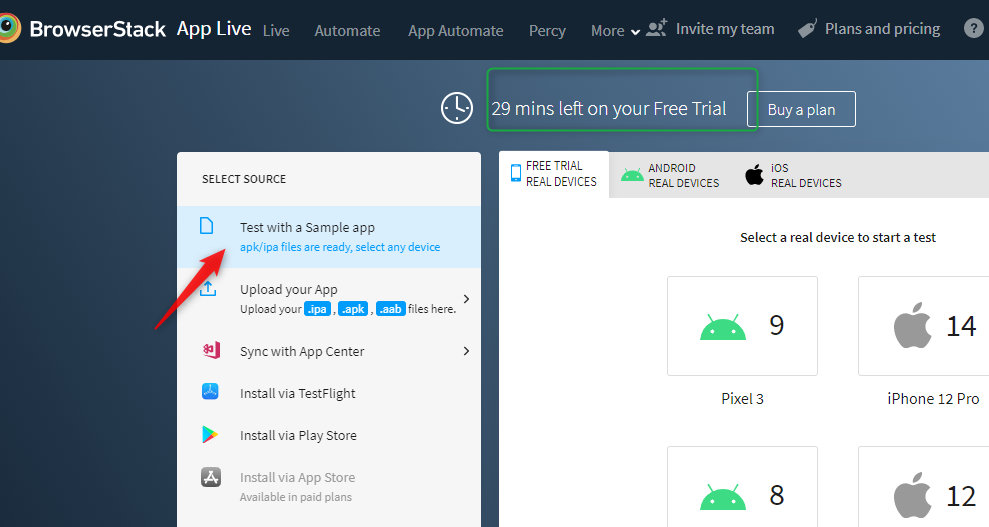
iv. Once you have chosen the Real Device that you want to test in, the App will launch.
v. You will get a split-screen view as you see in the below image.
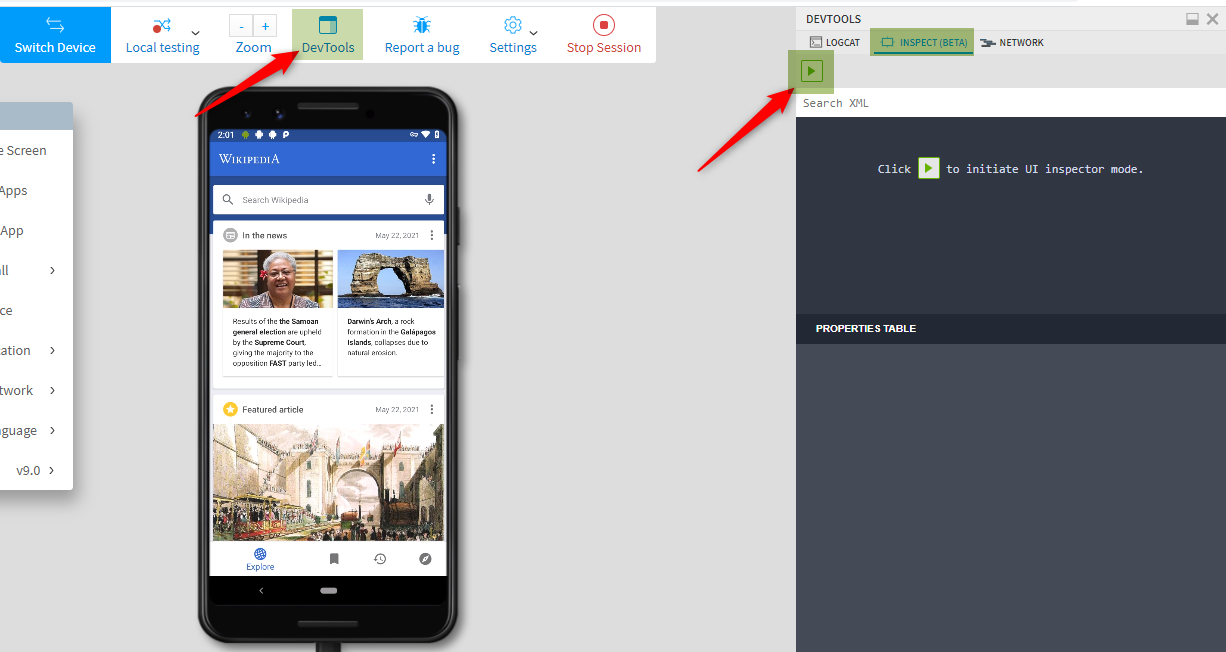
vi. So you will see a pane on the right side that will show the following three options, LOGCAT, INSPECT (BETA), and NETWORK
vii. Now, click on the ‘Inspect’ option, and then click on the ‘Play Button’ that appears to enable Inspector mode.
Inspector Mode
Once we have turned the Inspector mode on by clicking on the Play icon, we will easily be able to identify the locators and objects. All you have to do is hover the mouse over the element that you want to inspect on the mobile screen, and click on it. Once you have clicked, the XML snippet and the element we have selected will be highlighted as shown in the image below.
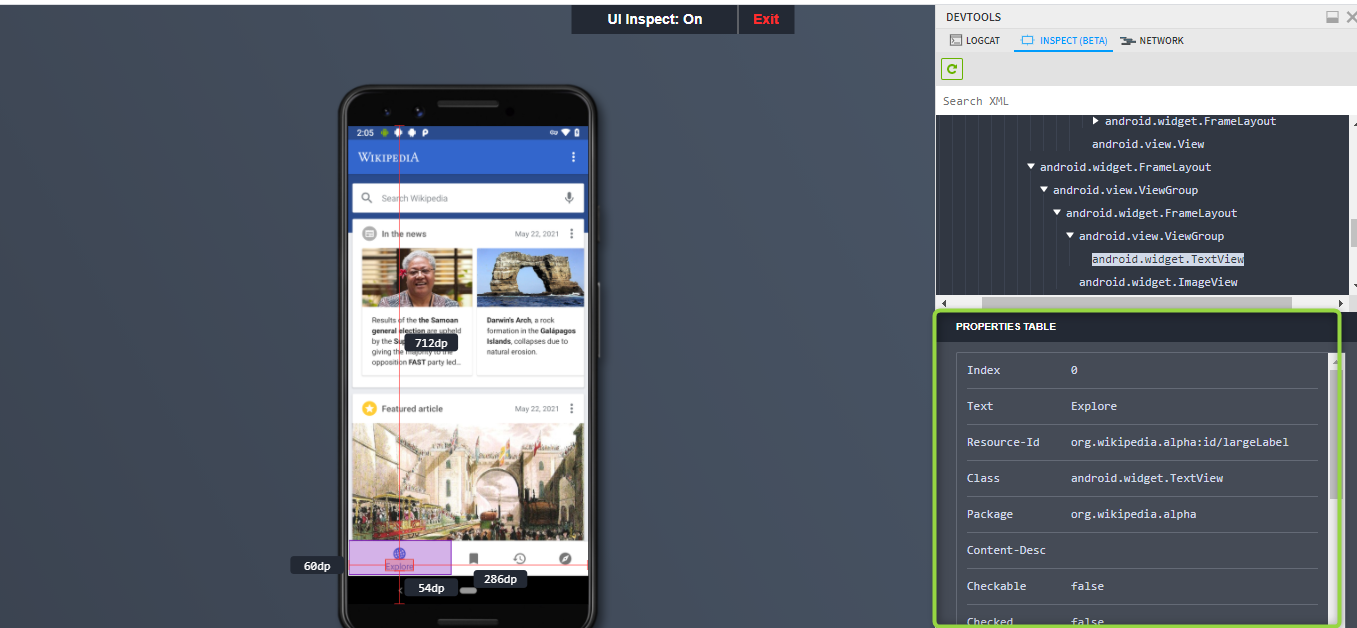
Right below the code snippers, we will be able to see the ‘Properties Table’ as well.
Highlighted XML code snippet:
>android.widget.ViewGroup
>android.widget.TextView
Properties Table:
The table will show attributes, keys, and values like the Resource-Id, Class name, Package Name, Index, Visible Text, etc…
Example:
Text: Login
Resource-Id: org.package:id/headerLabel
Class: android.widget.TextView
Package: org.package.alpha
Conclusion:
So using BrowserStack as a UI inspector is a very easy process that every tester must know. BrowserStack’s UI inspector has come in handy whenever there was any locator or object issue in the automation suite. We were able to come up with quick fixes and provide the best automation testing services to our clients as we were able to easily identify the locators and objects using BrowserStack. That is why specifically chose to cover that in this BrowserStack Tutorial. If you are looking to learn more about BrowserStack, kindly read our End-to-End guide on it.

by admin | Aug 23, 2021 | Automation Testing, Blog, Latest Post |
Dependency Injection is a design pattern used to create dependent objects outside a class and provide those objects to a class through different ways by implementing Inversion of Control. Using Dependency Injection, we can move the creation and binding of the dependent objects outside of the class that depends on them. JVM-Cucumber supports many different dependency injection frameworks, and one of them is Guice. As a leading QA company, we are always on the watch for new tools and frameworks to improve our testing process and so we tested out Guice as well. So in this blog, we will be showing you how to perform Cucumber Dependency Injection Using Guice.
Cucumber Dependency Injection Using Guice:
If you’re going to work in an automation framework from scratch or use an existing one, there are few aspects that you should keep in your mind. For example, you have to ensure that the framework is maintainable, easy to understand, helpful in avoiding coding duplicates, and quick to adapt to any changes. Though these are very basic aspects of a framework, it does require you to follow a few design principles and techniques in it. First off, let’s see why sharing the state between steps in Cucumber-JVM is a necessity.
Well, a Gherkin scenario is created by steps and each step depends on previous steps. That is why we must be able to share the state between steps. Since the tests are implemented as regular Java methods in regular Java classes. If steps are global, then every step in the same package or subpackage relative to the runner will be found and executed. This allows us to define one step in one class and another step in another class.
If you’re writing your first test, then there are high chances that you have just a few steps that can easily be fit into one class. But the real problem arises when there are a bunch of scenarios as it gets exponentially harder to maintain. So that is why dividing the steps between many classes is a good idea.
How do you share the state between different classes for Cucumber-JVM?
The recommended solution in Java is to use dependency injection. That is, inject a common object in each class with steps, an object that is recreated every time a new scenario is executed.
Note – Object State sharing is only for steps and not for scenarios.
Let’s take a look at an example scenario and find out how to share the state between multiple step definition files with a common object.
Example Scenario:
* David Orders a mobile phone from Amazon.
* He receives a defective product.
* He returns the product and requests a replacement.
* Amazon replaces the defective product.
Now, let’s split this example into the Gherkin format.
Cucumber-Guice\src\test\resources\Demo.feature
Feature: Replace the product
Scenario: Defective product should be replaced if user requests for replacement.
Given David orders the mobile phone from Amazon
When He returns the product for replacement
Then He will get a new product from Amazon
The example scenario we have seen talks about two different actions,
1. Purchasing a product from Amazon.
2. Returning a product.
So when we divide the implementation of the steps into different classes, the only file that gets affected is the steps definition. This is where Dependency Injection comes into play as we can use it to overcome this obstacle. So let’s see how to get it done using Guice.
The first change here would be to add new dependencies in the Maven POM File.
This is the dependency for Cucumber to use Guice:
<dependency>
<groupId>info.cukes</groupId>
<artifactId>cucumber-guice</artifactId>
<version>1.2.5</version>
<scope>test</scope>
</dependency>
This dependency to use Google Guice:
<dependency>
<groupId>com.google.inject</groupId>
<artifactId>guice</artifactId>
<version>4.1.0</version>
<scope>test</scope>
</dependency>
Maven POM File:
This is how the Maven POM file will look like:
pom.xml
<?xml version="1.0" encoding="UTF-8"?>
<project xmlns="http://maven.apache.org/POM/4.0.0"
xmlns:xsi="http://www.w3.org/2001/XMLSchema-instance"
xsi:schemaLocation="http://maven.apache.org/POM/4.0.0 http://maven.apache.org/xsd/maven-4.0.0.xsd">
<modelVersion>4.0.0</modelVersion>
<groupId>org.example</groupId>
<artifactId>Cucumber-Guice</artifactId>
<version>1.0-SNAPSHOT</version>
<properties>
<java.version>1.8</java.version>
<junit.version>4.12</junit.version>
<cucumber.version>1.2.5</cucumber.version>
<selenium.version>3.7.1</selenium.version>
<maven.compiler.source>1.6</maven.compiler.source>
<maven.compiler.target>1.6</maven.compiler.target>
</properties>
<dependencies>
<dependency>
<groupId>com.google.guava</groupId>
<artifactId>guava</artifactId>
<version>22.0</version>
</dependency>
<dependency>
<groupId>info.cukes</groupId>
<artifactId>cucumber-guice</artifactId>
<version>${cucumber.version}</version>
<scope>test</scope>
</dependency>
<dependency>
<groupId>com.google.inject</groupId>
<artifactId>guice</artifactId>
<version>4.1.0</version>
<scope>test</scope>
</dependency>
<dependency>
<groupId>info.cukes</groupId>
<artifactId>cucumber-java</artifactId>
<version>${cucumber.version}</version>
<scope>test</scope>
</dependency>
<dependency>
<groupId>info.cukes</groupId>
<artifactId>cucumber-core</artifactId>
<version>${cucumber.version}</version>
<scope>test</scope>
</dependency>
<dependency>
<groupId>info.cukes</groupId>
<artifactId>cucumber-junit</artifactId>
<version>${cucumber.version}</version>
<scope>test</scope>
</dependency>
<dependency>
<groupId>junit</groupId>
<artifactId>junit</artifactId>
<version>${junit.version}</version>
<scope>test</scope>
</dependency>
<dependency>
<groupId>org.seleniumhq.selenium</groupId>
<artifactId>selenium-java</artifactId>
<version>${selenium.version}</version>
<scope>test</scope>
</dependency>
<dependency>
<groupId>org.seleniumhq.selenium</groupId>
<artifactId>selenium-chrome-driver</artifactId>
<version>${selenium.version}</version>
<scope>test</scope>
</dependency>
</dependencies>
</project>
The next step would be to create two classes for the steps. Let’s call them CustomerSteps and ProductSteps.
The idea here is that these classes will share state between steps that depend on the result of an earlier step in the scenario. It is known that sharing state can be done in different ways, and we have used a new class that holds the common data here.
Example:
src\test\java\DemoGuice\Steps\DemoCotainer.java
package DemoGuice.Steps;
import DemoGuice.Pages.ProductPage;
import DemoGuice.Pages.CustomerPage;
import cucumber.runtime.java.guice.ScenarioScoped;
@ScenarioScoped
public class DemoCotainer {
CustomerPage customerPage ;
ProductPage productPage;
}
In the above code, the democontainer class is annotated with @ScenarioScoped. So Guice will be able to acknowledge it as something that should be created and made available in different classes.
If we want to use this common data in each step definition file, we can add a constructor that takes the democontainer as an argument. This is where the injection occurs and so let’s take a look at an example to understand it better.
Example:
src\test\java\DemoGuice\Steps\ProductSteps.java
public class ProductSteps {
private DemoCotainer demoCotainer;
@Inject
public ProductSteps(DemoCotainer demoCotainer) {
this.demoCotainer = demoCotainer;
}
Now we can use the democontainer to access all of the common fields that are needed across the step definition classes. Here, we have annotated the field democontainer with @Inject. It is worth mentioning that you have the choice to annotate a constructor or a field to allow Guice to set the value. This enables the shared democontainer object to be available for all the steps definition classes.
Implementation of ProductSteps class:
src\test\java\DemoGuice\Steps\ProductSteps.java
package DemoGuice.Steps;
import com.google.inject.Inject;
import cucumber.api.java.en.Given;
import cucumber.api.java.en.Then;
import cucumber.api.java.en.When;
public class ProductSteps {
private DemoCotainer demoCotainer;
@Inject
public ProductSteps(DemoCotainer demoCotainer) {
this.demoCotainer = demoCotainer;
}
@Given("^David orders the mobile phone from Amazon$")
public void davidOrdersTheMobilePhoneFromAmazon() {
demoCotainer.productPage.orderMobilePhone();
}
@When("^He returns the product for replacement$")
public void heReturnsTheProductForReplacement() {
demoCotainer.productPage.requestForReturn();
}
}
Implementation of CustomerSteps class:
src\test\java\DemoGuice\Steps\CustomerSteps.java
package DemoGuice.Steps;
import com.google.inject.Inject;
import cucumber.api.java.en.Given;
import cucumber.api.java.en.Then;
import static org.hamcrest.CoreMatchers.is;
import static org.junit.Assert.assertThat;
public class CustomerSteps {
@Inject
private DemoCotainer demoCotainer;
@Inject
public CustomerSteps(DemoCotainer demoCotainer) {
this.demoCotainer = demoCotainer;
}
@Then("^He will get new product from Amazon$")
public void heWillGetNewProductFromAmazon() {
demoCotainer.customerPage.receiveNewProduct();
}
}
Conclusion:
We hope you had an enjoyable read while also learning how to use Google Guice for performing cucumber dependency injection. Using Dependency Injection to organize our code better and share state between step definitions has been helpful in streamlining our process to provide the best automation testing services to all our clients. Make sure to stay connected with our blog for more informative blogs.

by admin | Aug 16, 2021 | AI Testing, Blog, Latest Post |
In recent years organizations have invested significantly in structuring their testing process to ensure continuous releases of high-quality software. But all that streamlining doesn’t apply when artificial intelligence enters the equation. Since the testing process itself is more challenging, organizations are now in a dire need of a different approach to keep up with the rapidly increasing inclusion of AI in the systems that are being created. AI technologies are primarily used to enhance our experience with the systems by improving efficiency and providing solutions for problems that require human intelligence to solve. Despite the high complexity of the AI systems that increase the possibility of errors, we have been able to successfully implement our AI testing strategies to deliver the best software testing services to our clients. So in this AI Testing Tutorial, we’ll be exploring the various ways we can handle AI Testing effectively.
Understanding AI
Let’s start this AI Testing Tutorial with a few basics before heading over to the strategies. The fundamental thing to know about machine learning and AI is that you need data, a lot of data. Since data plays a major role in the testing strategy, you would have to divide it into three parts, namely test set, development set, and training set. The next step is to understand how the three data sets work together to train a neural network before testing your AI-based application.
Deep learning systems are developed by feeding several data into a neural network. The data is fed into the neural network in the form of a well-defined input and expected output. After feeding data into the neural network, you wait for the network to give you a set of mathematical formulae that can be used to calculate the expected output for most of the data points that you feed the neural network.
For example, if you were creating an AI-based application to detect deformed cells in the human body. The computer-readable images that are fed into the system make up the input data, while the defined output for each image forms the expected result. That makes up your training set.
Difference between Traditional systems and AI systems
It is always smart to understand any new technology by comparing it with the previous technology. So we can use our experience in testing the traditional systems to easily understand the AI systems. The key to that lies in understanding how AI systems differ from traditional systems. Once we have understood that, we can make small tweaks and adjustments to the already acquired knowledge and start testing AI systems optimally.
Traditional Software Systems
Features:
Traditional software is deterministic, i.e., it is pre-programmed to provide a specific output based on a given set of inputs.
Accuracy:
The accuracy of the software depends upon the developer’s skill and is deemed successful only if it produces an output in accordance with its design.
Programming:
All software functions are designed based on loops and if-then concepts to convert the input data to output data.
Errors:
When any software encounters an error, remediation depends on human intelligence or a coded exit function.
AI Systems:
Now, we will see the contrast of the AI systems over the traditional system clearly to structure the testing process with the knowledge gathered from this understanding.
Features:
Artificial Intelligence/machine learning is non – deterministic, i.e., the algorithm can behave differently for different runs since the algorithms are continuously learning.
Accuracy:
The accuracy of AI learning algorithms depends on the training set and data inputs.
Programming:
Different input and output combinations are fed to the machine based on which it learns and defines the function.
Errors:
AI systems have self-healing capabilities whereby they resume operations after handling exceptions/errors.
From the difference between each topic under the two systems we now have a certain understanding with which we can make modifications when it comes to testing an AI-based application. Now let’s focus on the various testing strategies in the next phase of this AI Testing Tutorial.
Testing Strategy for AI Systems
It is better not to use a generic approach for all use cases, and that is why we have decided to give specific test strategies for specific functionalities. So it doesn’t matter if you are testing standalone cognitive features, AI platforms, AI-powered solutions, or even testing machine learning-based analytical models. We’ve got it all covered for you in this AI Testing Tutorial.
Testing standalone cognitive features
Natural Language Processing:
1. Test for ‘precision’ – Return of the keyboard, i.e., a fraction of relevant instances among the total retrieved instances of NLP.
2. Test for ‘recall’ – A fraction of retrieved instances over the total number of retrieved instances available.
3. Test for true positives, True negatives, False positives, False negatives. Confirm that FPs and FNs are within the defined error/fallout range.
Speech recognition inputs:
1. Conduct basic testing of the speech recognition software to see whether the system recognizes speech inputs.
2. Test for pattern recognition to determine if the system can identify when a unique phrase is repeated several times in a known accent and whether it can identify the same phrase when repeated in a different accent.
3. Test how speech translates to the response. For example, a query of “Find me a place where I can drink coffee” should not generate a response with coffee shops and driving directions. Instead, it should point to a public place or park where one can enjoy coffee.
Optical character recognition:
1. Test the OCR and Optical word recognition basics by using character or word input for the system to recognize.
2. Test supervised learning to see if the system can recognize characters or words from printed, written or cursive scripts.
3. Test deep learning, i.e., check whether the system can recognize the characters or words from skewed, speckled, or binarized documents.
4. Test constrained outputs by introducing a new word in a document that already has a defined lexicon with permitted words.
Image recognition:
1. Test the image recognition algorithm through basic forms and features.
2. Test supervised learning by distorting or blurring the image to determine the extent of recognition by the algorithm.
3. Test pattern recognition by replacing cartoons with the real image like showing a real dog instead of a cartoon dog.
4. Test deep learning scenarios to see if the system can find a portion of an object in a large image canvas and complete a specific action.
Now we will be focusing on the various strategies for algorithm testing, API integration, and so on in this AI Testing Tutorial as they are very important when it comes to testing AI platforms.
Algorithm testing:
1. Check the cumulative accuracy of hits (True positives and True negatives) over misses (False positives and False negatives)
2. Split the input data for learning and algorithm.
3. If the algorithm uses ambiguous datasets in which the output for a single input is not known, then the software should be tested by feeding a set of inputs and checking if the output is related. Such relationships must be soundly established to ensure that the algorithm doesn’t have defects.
4. If you are working with an AI which involves neural networks, you have to check it to see how good it is with the mathematical formulae that you have trained it with and how much it has learned from the training. Your training algorithm will show how good the neural network algorithm is with its result on the training data that you fed it with.
The Development set
However, the training set alone is not enough to evaluate the algorithm. In most cases, the neural network will correctly determine deformed cells in images that it has seen several times. But it may perform differently when fed with fresh images. The algorithm for determining deformed cells will only get one chance to assess every image in real-life usage, and that will determine its level of accuracy and reliability. So the major challenge is knowing how well the algorithm will work when presented with a new set of data that it isn’t trained on.
This new set of data is called the development set. It is the data set that determines how you modify and adjust your neural network model. You adjust the neural network based on how well the network performs on both the training and development sets, this means that it is good enough for day-to-day usage.
But if the data set doesn’t do well with the development set, you need to tweak the neural network model and train it again using the training set. After that, you need to evaluate the new performance of the network using the development set. You could also have several neural networks and select one for your application based on its performance on your development set.
API integration:
1. Verify the input request and response from each application programming interface (API).
2. Conduct integration testing of API and algorithms to verify the reconciliation of the output.
3. Test the communication between components to verify the input, the response returned, and the response format & correctness as well.
4. Verify request-response pairs.
Data source and conditioning testing:
1. Verify the quality of data from the various systems by checking their data correctness, completeness & appropriateness along with format checks, data lineage checks, and pattern analysis.
2. Test for both positive and negative scenarios.
3. Verify the transformation rules and logic applied to the raw data to get the output in the desired format. The testing methodology/automation framework should function irrespective of the nature of the data, be it tables, flat files, or big data.
4. Verify if the output queries or programs provide the intended data output.
System regression testing:
1. Conduct user interface and regression testing of the systems.
2. Check for system security, i.e., static and dynamic security testing.
3. Conduct end-to-end implementation testing for specific use cases like providing an input, verifying data ingestion & quality, testing the algorithms, verifying communication through the API layer, and reconciling the final output on the data visualization platform with the expected output.
Testing of AI-powered solutions
In this part of the AI Testing Tutorial, we will be focusing on strategies to use when testing AI-powered solutions.
RPA testing framework:
1. Use open-source automation or functional testing tools such as Selenium, Sikuli, Robot Class, AutoIT, and so on for multiple purposes.
2. Use a combination of pattern, text, voice, image, and optical character recognition testing techniques with functional automation for true end-to-end testing of applications.
3. Use flexible test scripts with the ability to switch between machine language programming (which is required as an input to the robot) and high-level language for functional automation.
Chatbot testing framework:
1. Maintain the configurations of basic and advanced semantically equivalent sentences with formal & informal tones, and complex words.
2. Generate automated scripts in python for execution.
3. Test the chatbot framework using semantically equivalent sentences and create an automated library for this purpose.
4. Automate an end-to-end scenario that involves requesting for the chatbot, getting a response, and finally validating the response action with accepted output.
Testing ML-based analytical models
Analytical models are built by the organization for the following three main purposes.
Descriptive Analytics:
Historical data analysis and visualization.
Predictive Analytics:
Predicting the future based on past data.
Prescriptive Analytics:
Prescribing course of action from past data.
Three steps of validation strategies are used while testing the analytical model:
1. Split the historical data into test & train datasets.
2. Train and test the model based on generated datasets.
3. Report the accuracy of the model for the various generated scenarios as well.
All types of testing are similar:
It’s natural to feel overwhelmed after seeing such complexity. But as a tester, if one is able to see through the complexity, they will be able to that the foundation of testing is quite similar for both AI-based and traditional systems. So what we mean by this is that the specifics might be different, but the processes are almost identical.
First, you need to determine and set your requirements. Then you need to assess the risk of failure for each test case before running tests and determining if the weighted aggregated results are at a predefined level or above the predefined level. After that, you need to run some exploratory testing to find biased results or bugs as in regular apps. Like we said earlier, you can master AI testing by building on your existing knowledge.
With all that said, we know for a fact that an AI-based system provides a highly functional dynamic output with the same input when it is run again and again since the ML algorithm is a learning algorithm. Also, most of the applications today have some type of Machine Learning functionality to enhance the relationship of the applications with the users. AI inclusion on a much larger scale is inevitable as we humans will stop at nothing until the software we create has human-like functionalities. So it’s necessary for us to adapt to the progress of this AI revolution.
Conclusion:
We hope that this AI Testing Tutorial has helped you understand the AI algorithms and their nature that will enable you to tailor your own test strategies and test cases that cater to your needs. Applying out-of-the-box thinking is crucial for testing AI-based applications. As a leading QA company, we always implement the state of the art strategies and technologies to ensure quality irrespective of the software being AI-based or not.

by admin | Aug 12, 2021 | Mobile App Testing, Blog, Latest Post |
Mobile apps are a lucrative way to focus your software, programming, and coding skills into a digital product. Earnings in the industry totaled more than 1 billion in late 2020. Apps make the current digital world operate daily, with more than 90 percent of mobile users online spending most of their time on apps.
If you’re a starting-level mobile app developer already working with a small team, your app, program, or software may benefit from third-party software testing services that can help you streamline your work, reducing potential conflicts and bugs. It may even hasten the product and cut costs by doing so. Here are some details:
Quality-Check Your App
Companies who create and invest in apps, software, programs, and games may find it more beneficial if they worked with a separate testing company to analyze their work. It could speed up their test process by collaborating with testers and get their programs checked to ensure their final product never goes through delays in revisions, bug fixes, or challenges in design and controls.
A third-party review also separates the company’s views from their work for a more thorough technical check.
This often happens in games and software. When released, games might be delayed before the release date due to error-fixing and patching. Ultimately, creating apps and programs and running the detailed tedious processes after are two separate endeavors. Any steps in testing and retesting your work can be shortened by using professional mobile testing companies that provide complete test results.
Whether your software is an app, a platform for mass use with a service, or dedicated inter-office software for use by a small company, QA services will help with faster analysis and testing to lessen costs, delays, and bugs.
Testing Facilities and Automation
App and software developers will later need teams to maintain and update their apps and programs. One solution offered to reduce costs and time issues is to use test automation services.
For testing and maintenance, updating, patches, or additions, these companies can provide the device test labs that most companies don’t have, which will be key to figuring out your next updates. The test team can see the results from various users and devices and make changes faster.
Automation services can help you save time running diagnostics and tests on software and app projects by providing reliable cloud services hosting these tools. This is another important next step and can affect the quality and delivery schedules.
Conclusion
Bringing your software, app, game, or program to the big stage without any running issues is the goal of many developers. But this will happen if you enlist QA services to see how well and error-free they run before your final deployment. Make sure you meet quality standards and learn all possible issues of your project so it can be fixed before it reaches the deadline.
Instead of testing without gathering the cause triggers of bugs patches and fixes, why not bring it to Codoid instead? We are one of the top automation testing companies online with an ISO 9001:2015 Certification—the strictest global-quality testing levels. Outsourcing your mobile application labs, testing, and maintenance is a good idea. Do ittoday.


